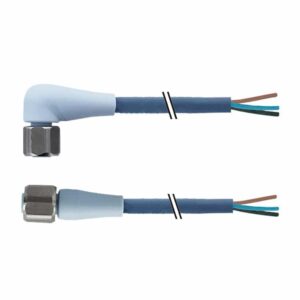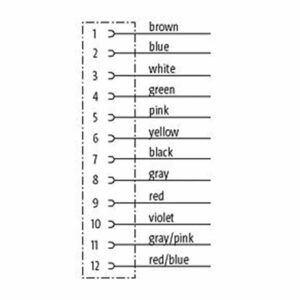Industrial systems and networks are carefully mapped out to meet demands and expectations. A subject within this domain is connection technology. This consists of the tools necessary to connect components and subsystems to each other. Examples of connection technology are distribution boxes and cables.
In this article, we cover the cables used in various industrial applications to enable power supply and communication of sensors. There are many different types of cables that can be typified by a number of important properties, which we will discuss in this article. We conclude with an overview of the types of cables and their differences.
Cables with connectors: M8, M12 and M16
Cables can have different types of connectors that vary based on the shape and number of pins. If we have a sensor with an M12 connection, the connector of the cable that we want to connect to it must also have this size. For example, there are different designs in (the connections of) sensors and therefore also cables. The main sizes are M8, M12 and M16.
Finding the right size is just one thing to check off when choosing a cable. Every sensor has, based on the functionality of it, a different number of pins. These are the pins over which the electric signals from the sensor to the cable, and the other way arround, must run. The number of pins on the connector of the sensor and the cable offcourse have to match for full functionality. A 4-pin M12 cable on a 5-pin M12 sensor will work, but the functionality of the 5th pin is missing.

Cables of different materials

Cables come in different materials. The material determines its usefulness in an application, or vice versa; an application may require a certain type of material. The main materials for industrial use are: PVC, TPE and PUR.
PVC, also called polyvinyl chloride, is a common material in everyday applications and is therefore a good choice in less critical areas of application. It is a durable material that is also favorable in terms of price.
TPE, also known as thermoplastic elastomer, is a type of rubber that lends itself well to applications where the cable is exposed to higher temperatures and shocks (impact). It is also good to use in all weather conditions and is also very suitable for the food industry.
PUR, also known as polyurethane, is a very flexible and shock-resistant cable material; even in lower temperatures. In addition, it has better resistance to various liquids such as water and oil.
Shielding and twisting
Cables can be provided with a so-called shield. This is an insulating sheath that is wrapped around the wires in a cable. When the wires are under voltage and current flows through them, this material prevents the electromagnetic field from coming out of the cable, but also the other way around: electromagnetic fields (from nearby cables, for example) cannot reach the wires. This prevents noise and interference in the signals that run through a cable.
When twisting, wires are wrapped around each other in a cable. Cores belonging to the same circuit are intended to be coupled together. As a result, these wires have an increased so-called electromagnetic compatibility (also known as EMC). This prevents noise and disturbance of the signal by the cores in the cable.

Bending and dragchain cables
There are applications in which cables must be connected to a robot (arm) or a moving machine. Think of a pneumatic robotic arm that welds the chassis of a car together. Due to the dynamic nature of these applications, there is a high risk of cable breakage. To prevent this, there are cables of various materials that can move along without breaking, such as TPE and PUR.
In our range we call these types of bendable cables: dragchain cables. These are the cables that can be passed through a chain or can be placed in a robot arm. These are equipped for use in a constantly moving system where the risk of cable breakage is high.
Another risk for a cable break is an application in which the cable or connector cannot be easily installed. Think of a conveyor with too narrow spaces on the track sides. For this there are cables with a right angle connector. The connector is then rotated 90 degrees, so that the cable and connector together take up less space from the connection.
Interfaces and color coding

Each core in a cable has a separate color coding, which makes it clear what the signal is for. As an example, let's take a 4-core cable that is connected to a 4-pin connection. The sensor manufacturer indicates (in the manual) which wire of the cable corresponds to which input / output function of the sensor. One sensor will use a white wire in a cable for a different type of signal than another.
The reason for this is the difference in interfaces. In short, an interface is a interface or connection between two different systems. In this case the sensor and the rest of the machinery to which it is connected. One interface will use the white wire to supply input signals while a sensor with a different type of interface will use it for a teach signal.
Which cable is suited for your application?
As may have become apparent from the above information, there are many variables and differences between cables. To get more clarity, we have listed the main specifications per type of cable in a table. This allows you to compare the cables and make an easier choice. Our experts are happy to help you with appropriate advice when you contact us!






